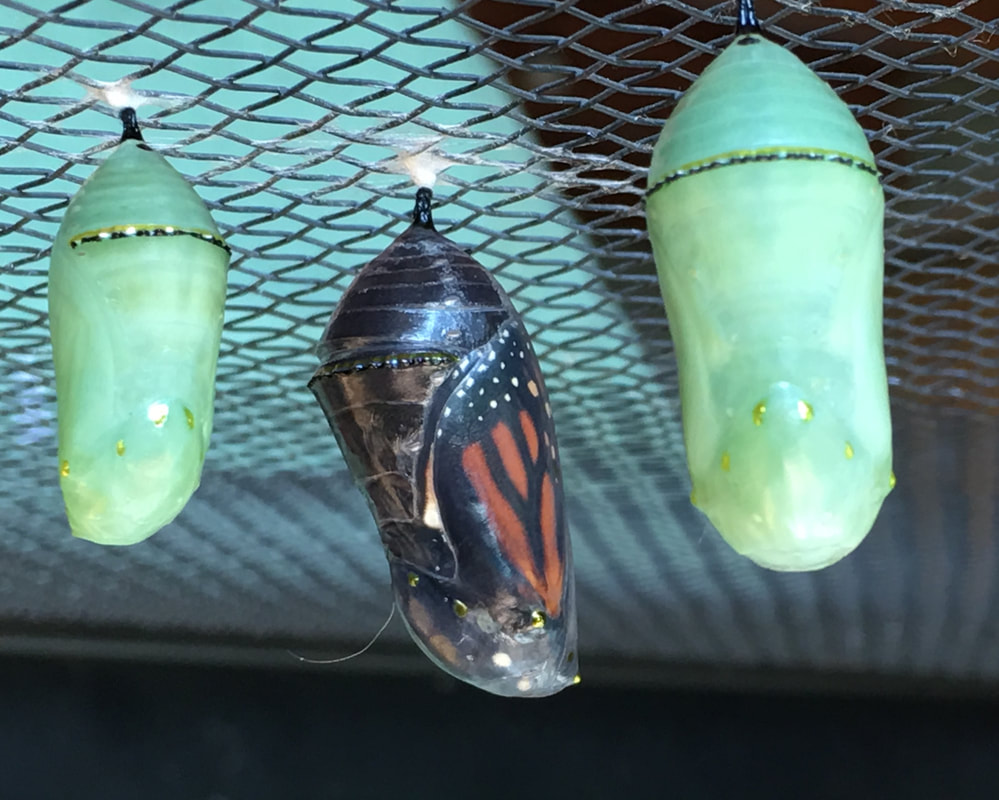|
A Field Guide to Raising Butterflies
There is a magical process that takes place starting in late spring through fall in our area. It is the complete metamorphosis of a monarch caterpillar to a butterfly. Looking at the caterpillar, one of the first things that goes through your mind is how does this striped caterpillar become a butterfly? What part of the caterpillar is the wings? Which part is the thorax? Do the legs become wings? It is a wondrous process to witness the transition. When it breaks through the chrysalis and crawls out, the monarch's wings are completely crumpled up. The thorax or body is huge and filled with fluid. It’s first moments as a butterfly are spent pumping fluid from the thorax to fill and expand the wings. You have to be quick to capture the process. After it looks like a typical monarch, it will rest and occasionally flap its wings to dry them. A few years ago, I started collecting monarch eggs or small caterpillars and started bringing them inside. Why would I do that? One more thing to take care of, one more thing to worry about. But if you have heard the news, you know monarch populations have dropped off considerably. We have good years, but overall, there are fewer monarchs. There is a strong statement typically made about monarchs, that they produce a taste that is offensive or toxic to predators. That is true to an extent, but predators get around that sticky issue. First, ants, tree frogs and other predator insects will eat the entire egg. If the monarch survives to hatch, it may still be consumed by those insects and tree frogs. The bluebird has apparently learned how to eliminate the toxic part of the caterpillar so it can be fed to its hatchlings. That leads to the conundrum of who is more important; the bluebird or the monarch? No fear, by bringing the caterpillars inside your home or inside a protected enclosure, the monarch is protected from food predators. But more importantly it protects them from being infected with one of several diseases which also kills the monarch. So what can we do to make it easier for the monarch if you cannot provide them a protected home? Giving them plenty of native plants along with various forms of milkweed is a great way to start. Plants like Joe Pye Weed (Eupatorium or Eutrochium macrolatum), Meadow Blazing Star (Liatris ligulistylis), and Lead Plant (Amorpha canescens) along with many more, will feed your monarch butterfly once it is released. Milkweed or butterfly weed (Asclepias tuberosa) is important for the butterfly to lay eggs, so keep those within an area of your yard. If you find common milkweed too invasive, swamp milkweed(Asclepias incarnata) is an excellent substitute that is native to our area and is less invasive. We still have many monarchs to marvel at as summer slowly wanes. Look for chrysalises on Milkweed plants, watch the butterflies emerge, and make plans to actively raise them next year. Beth Martin is a Master Gardener here at Burlington Garden Center where you will find many plants helpful to the butterfly lifecycle. Feel free to contact Beth at [email protected].
1 Comment
|
|
|
STORE INFO
5205 Mormon Road Burlington, WI 53105 262.763.2153 |

